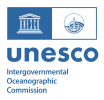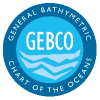Upcoming changes to the GEBCO WMS
October 2025: The WMS 'GEBCO_latest' layers are currently based on the GEBCO_2024 Grid. We are working to produce WMS layers based on the GEBCO_2025 Grid. These layers will be available shortly.
Please Note:
The GEBCO Web Map Service URLS of the form:https://www.gebco.net/data_and_products/gebco_web_services/web_map_services/web_map_service/mapserv? will be switched off on 12th September 2024.
Please see our news page for a list of the changes.
GEBCO WMS
The GEBCO grid is available as a Web Map Service (WMS), a means of accessing geo-referenced map images over the internet. These maps can be viewed in a web browser or Geographic Information System (GIS) and incorporated in your own web application.
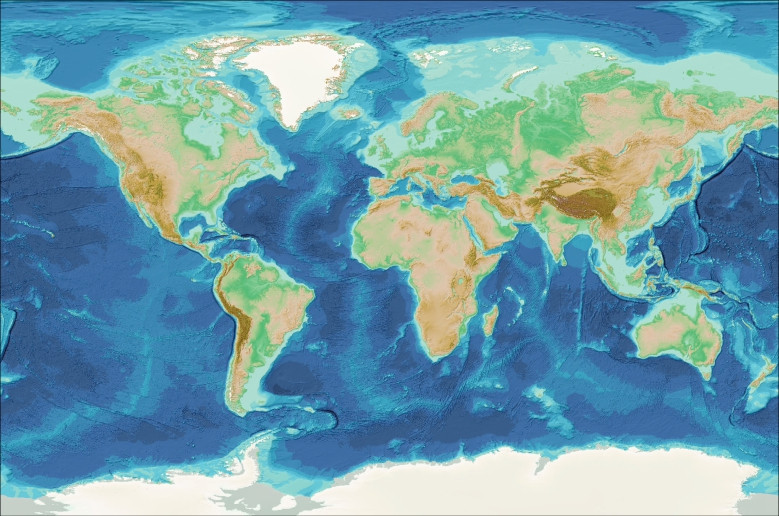
Layers are available as shaded relief image or 'flat' map and the GEBCO Type Identifier (TID) grid. These layers can be viewed in a web browser or Geographic Information System (GIS) and incorporated in your own web application.
The WMS layers are accessible from the following URL: https://wms.gebco.net/mapserv?
- Supported service requests
- Test WMS layers for the GEBCO_2025 Grid
- Test WMS layers for polar regions
- How can I view a WMS?
- Data sources and WMS development
- Data set acknowledgement
- Access previous GEBCO WMS layers
- Disclaimer
Previous versions of the GEBCO WMS layers will continue to be made available.

Example image from a GetMap call to the GEBCO WMS
Supported service requests
Please note: These service calls return layers based on the GEBCO_2024 Grid. We are working to make WMS layers available based on the GEBCO_2025 Grid.
GetCapabilities
This request returns information about the layers contained in the service, for example, their content and geographic extent. The information is returned in the form of a XML file (you may need to save this to disk to view the information).
The following links provide access to example GetCapabilities calls to GEBCO's WMS.
- WMS 1.3.0 GetCapabilities request for the global GEBCO grid
WMS 1.1.1 GetCapabilities requestfor the global GEBCO grid
GetMap
This request returns a map. Using the information given in the GetCapabilities request, the user can specify parameters such as the required layer, the geographic extent of the map and the size of the returned image.
Please note that the longitude range for the global WMS extends from -180 to 360 degrees to allow plotting centred on 180 degrees.
The following are example GetMap requests for GEBCO's WMS.
GEBCO_2024 Grid - with ice surface elevation information
- WMS 1.3.0 GetMap request for the global GEBCO Grid displayed as a shaded relief image
- WMS 1.3.0 GetMap request for the global GEBCO Grid displayed as a 'flat map' image, colour-coded for elevation
- WMS 1.3.0 GetMap request for the global GEBCO Grid displayed as a 'flat map' image, colour-coded for elevation, showing areas based on measured data only
GEBCO_2024 Grid - with sub-ice topography/bathymetry information
- WMS 1.3.0 GetMap request for the global GEBCO Grid displayed as a shaded relief image
GEBCO_2024 Type Identifier (TID) Grid
- WMS 1.3.0 GetMap request for the global TID Grid - grid cells based on measured data shown in black
- WMS 1.3.0 GetMap request for the global TID Grid - grid cells colour-coded by TID value
Test WMS layers for the GEBCO_2025 Grid
The GEBCO_2025 Grid was published in August 2025. A set of WMS layers, based on the GEBCO_2025 Grid, have been developed, links to these layers are given below. It is intended that the 'GEBCO_latest' layers of the GEBCO WMS 'https://wms.gebco.net/mapserv?' will be replaced with layers based on the GEBCO_2025 Grid in the near future.
GetCapabilities
This request returns information about the layers contained in the service, for example, their content and geographic extent. The information is returned in the form of a XML file (you may need to save this to disk to view the information).
The following links provide access to example GetCapabilities calls to GEBCO's WMS.
- WMS 1.3.0 GetCapabilities request for the global GEBCO grid
WMS 1.1.1 GetCapabilities requestfor the global GEBCO grid
GetMap
This request returns a map. Using the information given in the GetCapabilities request, the user can specify parameters such as the required layer, the geographic extent of the map and the size of the returned image.
Please note that the longitude range for the global WMS extends from -180 to 360 degrees to allow plotting centred on 180 degrees.
The following are example GetMap requests for GEBCO's WMS.
GEBCO_2025 Grid - with ice surface elevation information
- WMS 1.3.0 GetMap request for the global GEBCO Grid displayed as a 'flat map' image, colour-coded for elevation
- WMS 1.3.0 GetMap request for the global GEBCO Grid displayed as a 'flat map' image, colour-coded for elevation, showing areas based on measured data only
GEBCO_2025 Grid - with sub-ice topography/bathymetry information
- WMS 1.3.0 GetMap request for the global GEBCO Grid displayed as a 'flat map' image, colour-coded for elevation
GEBCO_2025 Type Identifier (TID) Grid
- WMS 1.3.0 GetMap request for the global TID Grid - grid cells based on measured data shown in black
- WMS 1.3.0 GetMap request for the global TID Grid - grid cells colour-coded by TID value
Test WMS layers for polar regions
Test WMS layers showing the bathymetry of the Arctic Ocean and Southern Ocean areas are available from the links below. Please provide any feedback on these layers to the Nippon Foundation-GEBCO Seabed 2030 Project Global Center (GDACC) gdacc@seabed2030.org .
Arctic Ocean region
The data for this region are taken from version 5.0 of the International Bathymetric Chart of the Arctic Ocean (IBCAO) and included as a regional compilation in the GEBCO_2022 grid. The WMS provides layers displayed in WGS 84 / IBCAO Polar Stereographic projection (EPSG:3996).
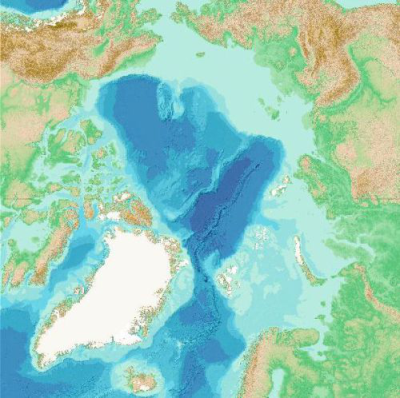
Example image from a GetMap call to the Arctic Ocean region WMS
The WMS layers are accessible from the following URL:https://wms.gebco.net/2024/north-polar/mapserv?
GetCapabilities
This request returns information about the layers contained in the service, for example, their content and geographic extent. The information is returned in the form of a XML file (you may need to save this to disk to view the information).
GetMap
This request returns a map. Using the information given in the GetCapabilities request, the user can specify parameters such as the required layer, the geographic extent of the map and the size of the returned image.
The following are example GetMap requests for GEBCO's WMS.
With ice surface elevation information
- WMS 1.3.0 GetMap request for the Arctic region displayed as a shaded relief image
With sub-ice topography/bathymetry information
- WMS 1.3.0 GetMap request for the Arctic region displayed as a shaded relief image
Type Identifier (TID) Grid
- WMS 1.3.0 GetMap request for the TID Grid for the Arctic region - grid cells based on measured data are shown in black
- WMS 1.3.0 GetMap request for the TID Grid for the Arctic region - grid cells colour-coded by TID value
Southern Ocean region
This data set was included as a regional compilation in the GEBCO_2024 grid.
The WMS provides layers displayed in WGS 84/ IBCSO Polar Stereographic projection (EPSG: 9354).
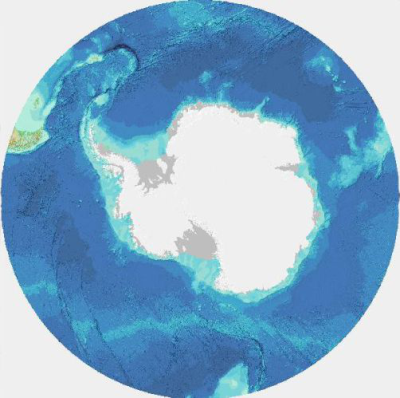
Example image from a GetMap call to the Southern Ocean region WMS
The WMS layers are accessible from the following URL:https://wms.gebco.net/2024/south-polar/mapserv?
GetCapabilities
This request returns information about the layers contained in the service, for example, their content and geographic extent. The information is returned in the form of a XML file (you may need to save this to disk to view the information).
GetMap
This request returns a map. Using the information given in the GetCapabilities request, the user can specify parameters such as the required layer, the geographic extent of the map and the size of the returned image.
The following are example GetMap requests for GEBCO's WMS.
With ice surface elevation information
- WMS 1.3.0 GetMap request for the Southern Ocean region displayed as a shaded relief image
With sub-ice topography/bathymetry information
- WMS 1.3.0 GetMap request for the Southern Ocean region displayed as a shaded relief image
Type Identifier (TID) Grid
- WMS 1.3.0 GetMap request for the TID Grid for the Southern Ocean region - grid cells based on measured data are shown in black
- WMS 1.3.0 GetMap request for the TID Grid for the Southern Ocean region - grid cells colour-coded by TID value
How can I view a WMS?
WMS are designed to allow imagery to be shared over the internet, i.e. within your own application or software package you can access a map hosted on a remote server.
The GetMap request can be used to view a WMS in a web browser. Just cut and paste this URL into your browser to view the WMS image; changing the BBOX values alters the geographic extent of the area viewed.
The GetCapabilities request provides information about the image layers contained in the WMS.
There are a number of commercial and free GIS and mapping-type packages in which you can view WMS.
Please note that the quality of the viewed image may depend on how the software package interprets the WMS.
Data sources and WMS development
The GEBCO WMS is largely based on the latest GEBCO Grid. The grid is based on a database of ship-track soundings with interpolation between soundings guided by satellite-derived gravity data. However, in regions where they improve on the existing grid, data sets generated by other methods are included.
Further information can be found in the documentation that accompanies the data set.
Access previous GEBCO WMS layers
Find out how to access WMS layers for previous GEBCO grid releases.
Data set acknowledgement
If imagery from the WMS is included in web sites, reports and digital and printed imagery then we request that the source of the data set is acknowledged and be of the form
"Imagery reproduced from the GEBCO_2022 Grid, GEBCO Compilation Group (2022) GEBCO_2022 Grid (doi:10.5285/e0f0bb80-ab44-2739-e053-6c86abc0289c)"
Disclaimer
GEBCO's WMS have been developed and made available, on behalf of GEBCO, by the British Oceanographic Data Centre (BODC).
Whilst every effort has been made to make sure that the imagery is as error free as possible, BODC and GEBCO give no warranty as to the quality, accuracy or completeness of the imagery contained within this WMS or to the non-interruption or continuation of the service. Furthermore we can give no warranty that this WMS is compatible with any other data with which the material is to be used.
The imagery within this WMS should not be used for navigation or for any purpose relating to safety at sea.

